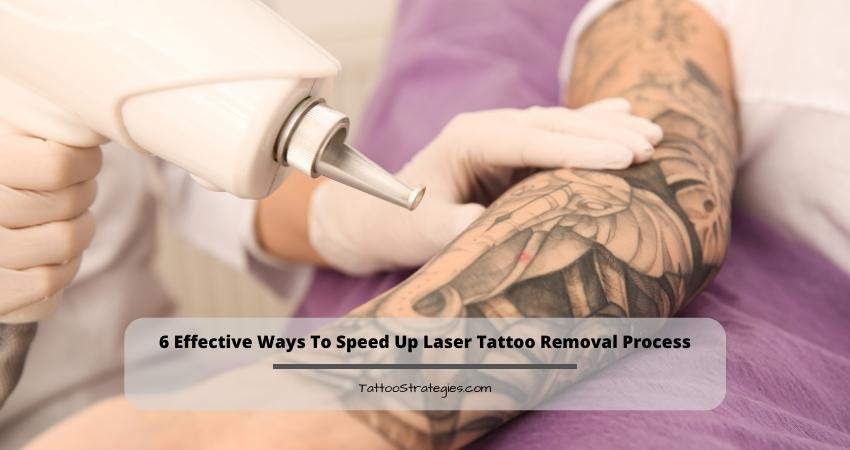6 Effective Ways To Speed Up Laser Tattoo Removal Process
Let’s guess it, you probably regret a silly tattoo you made when you are a lot younger and your perspective has changed so far. Or you want to remove your tattoo because it is harming your professional life.
But the laser tattoo removal process is very painful so you would do anything to lessen the pain and make the process faster. So, how to speed up the laser tattoo removal process?
You can’t necessarily do anything that might drastically lessen the time period for your appointments. But you could do certain things that might make the process smoother and less difficult for you. These steps include taking the right food, doing exercise, not missing the appointment, and a few more.
Read the full article to understand in depth how to reduce the time for the tattoo removal process.

What Factors Affect The Tattoo Removal Process?
Tattoo removal time depends on many variables. These are not “one size fits all” timelines, but they will give your doctor a basic sense of how long and how many treatments you will require.
1. Tattoo Size
A bigger tattoo will, of course, take more effort to cover up than a smaller one. They don’t last the same length of time while they’re on, and they won’t disappear at the same rate when they’re off.
Wedding rings are among the most often removed tattoos. As a result of their manageable size, they are usually straightforward to hoist.
Expect the operation to take somewhat longer if you want to remove a bigger item, such as a partial sleeve.
2. Ink Color
The more difficult the ink is to dissolve, the darker it gets. Watercolor tattoos, especially those with muted pastels, may be rather easy to have done.
More treatments will be required, however, if you have a lot of thick, black lines (like those in tribal bands) to deal with.

3. How Much Do You Want to Fade Your Tattoo
Would you want to have the tattoo totally erased, or only lightened so that it can be covered up again? In certain cases, having the tattoo completely removed is unnecessary.
Tattoos are notoriously difficult to erase, making it more practical to cover them up with anything else.
The skin will be better able to retain new ink if the previous tattoo fades off, so a fresh new piece of art may take its place.
4. Skin Color
The faster the removal process, the closer your skin tone is to the target hue. To get rid of a tattoo, what really happens is that it fades away.
It is finished when the ink has faded to the same level as the host pigment. The ink may have faded somewhat under the skin’s surface, but it is no longer visible.
5. Skin Health
Your skin will respond better to the therapy if it is in better condition, to begin with. In order to promote recovery, sessions should be scheduled at regular intervals.
When it comes to the number of sessions that can be completed in a given time frame, skin that is in good enough condition to regenerate swiftly will fare the best.
Not only are they not the only contributing elements, but they are the most typical ones. However, you shouldn’t be shocked if your doctor brings up anything else that could affect the number of sessions you need.
The specifics of your situation will be unlike anyone else’s since every individual is different.

6. Age Of The Tattoo
An older tattoo will have naturally faded more than a newer one. The ink on a tattoo that has faded is already starting to crack. Because of this, fewer laser treatments could be required.
Similarly, low-quality ink will deteriorate more quickly and easily than good ink would. This may seem like a silver lining in the cloud of having to remove a tattoo done in an unsanitary location by someone who is not a certified expert, but it may be your only option.
How to Speed Up Tattoo Removal Process: 6 Fruitful Ways!
These are the steps you should take when you are going through the laser removal process. Just follow these six steps to make the process a bit faster and healthier.
1. Avoid Exposing Your Skin To The Sun
Sunlight causes an increase in melanin production in the skin, which acts as a natural sunscreen by soaking up the sun’s harmful rays. In order for laser tattoo removal to be successful, your skin should not have too much melanin in it.
Increased melanin levels not only make your skin more prone to scorching but also make it more difficult for the laser to break up the ink pigment.
Keep the tattooed region away from direct sunlight for at least six weeks before starting treatment to get the best potential results from as few treatments as feasible.
Read More: Can You Tan After Laser Tattoo Removal?
2. Do Exercise
Boosting blood flow to the whole body is one of the many health benefits of exercise. If your blood flows well, your skin cells can take up all the oxygen they need. Regenerating and repairing cells need oxygen just as much as they require water.
Ink may be broken down by laser treatments, restoring your natural pigmentation. Your own body’s natural processes will be responsible for restoring the pigment. Provide it with what it needs.
3. Follow A Healthy Diet Plan
The skin also benefits from consuming protein. Skin cell development and regeneration are encouraged by sticking to a healthy diet that’s low in sugar and rich in lean protein.
New medical research also suggests that lean proteins might help increase pain tolerance.
4. Avoid Smoking
Evidence suggests that smoking significantly slows down the tattoo removal procedure. After 10 sessions, a smoker’s odds of having a tattoo removed are 70% lower, according to research.
There are many health advantages to quitting smoking, and if you’re also anxious to cover up certain tattoos you don’t like, this might be the last push you need.
5. Keep Up With The Appointment Schedule
It’s probably apparent, but sticking to your treatment schedule can help you see results more quickly. Tattoo removal will go at a slower pace if sessions are missed. But you shouldn’t schedule sessions too close together.
Sessions should be spaced out by at least two months to let your body break down and flush out the ink particles for your skin to recover properly.
6. Don’t Get Tattooed Again For Some Time
After getting a new tattoo, you’ll need to give your skin time to recover. You undoubtedly recall how the inked region itched and felt hot for a while after the procedure.
You shouldn’t try to heal many things at once. Your immune system may not like the distraction, even if you are ready to get a new tattoo elsewhere on your body.
Get rid of all the old ink completely first. Once this is done, you may continue working on your drawing.
Read More: Can you tattoo over a laser removed tattoo?
How Many Sessions Does It Take To Remove A Tattoo?
There are several variables that will determine how many laser tattoo removal sessions you will require.
During your appointment, we will go through these details and offer you a somewhat accurate estimate of the number of sessions you will need.
Even if your sample is very small or fading, you shouldn’t think that your laser removal will be done in just one or two sessions. There will likely be a lot of meetings, and they may occur over a long period of time (months or perhaps years).
Read More: How long to wait between tattoo removal sessions?
Tattoo Removal Process: A Few More Words About It
You may anticipate receiving a little anesthetic at your scheduled laser removal appointment. Your pain from laser therapy won’t be felt because of this. A lengthy session is not in the cards for you.
Laser tattoo removal is the most effective when done in many short sessions spread out over time. This will allow your skin to repair itself and the pigment to naturally fade away in the period that passes between treatments.
To speed up the healing process, make sure the injured area stays clean and dry. Your doctor may recommend using an antibacterial ointment on the skin to prevent infection.
Read More: Picosure Tattoo Removal
Frequently Asked Questions
Does Alcohol Consumption Affect My Tattoo Removal Process?
Avoid or at least limit alcohol consumption in the days leading up to laser treatment for elimination. Avoiding alcohol entirely is recommended, even if it means waiting up to a year to resume drinking after finishing laser removal treatments. Believe me, you won’t regret it.
Are Some Tattoos Impossible To Remove?
Even if the tattoo is completely removed, the skin probably won’t be the same as it was before it was inked.
Why Is My Tattoo Darker After Laser Removal?
Final Words
The tattoo removal process is painful and takes a bit of time. By now, you should know how to speed up the laser tattoo removal process.
All you can do is generally lead a healthier life so that you don’t make the tattoo removal process difficult. These include eating healthy, exercising, and drinking a lot of water. Also, keep your appointments in check.
Good luck with the session!
